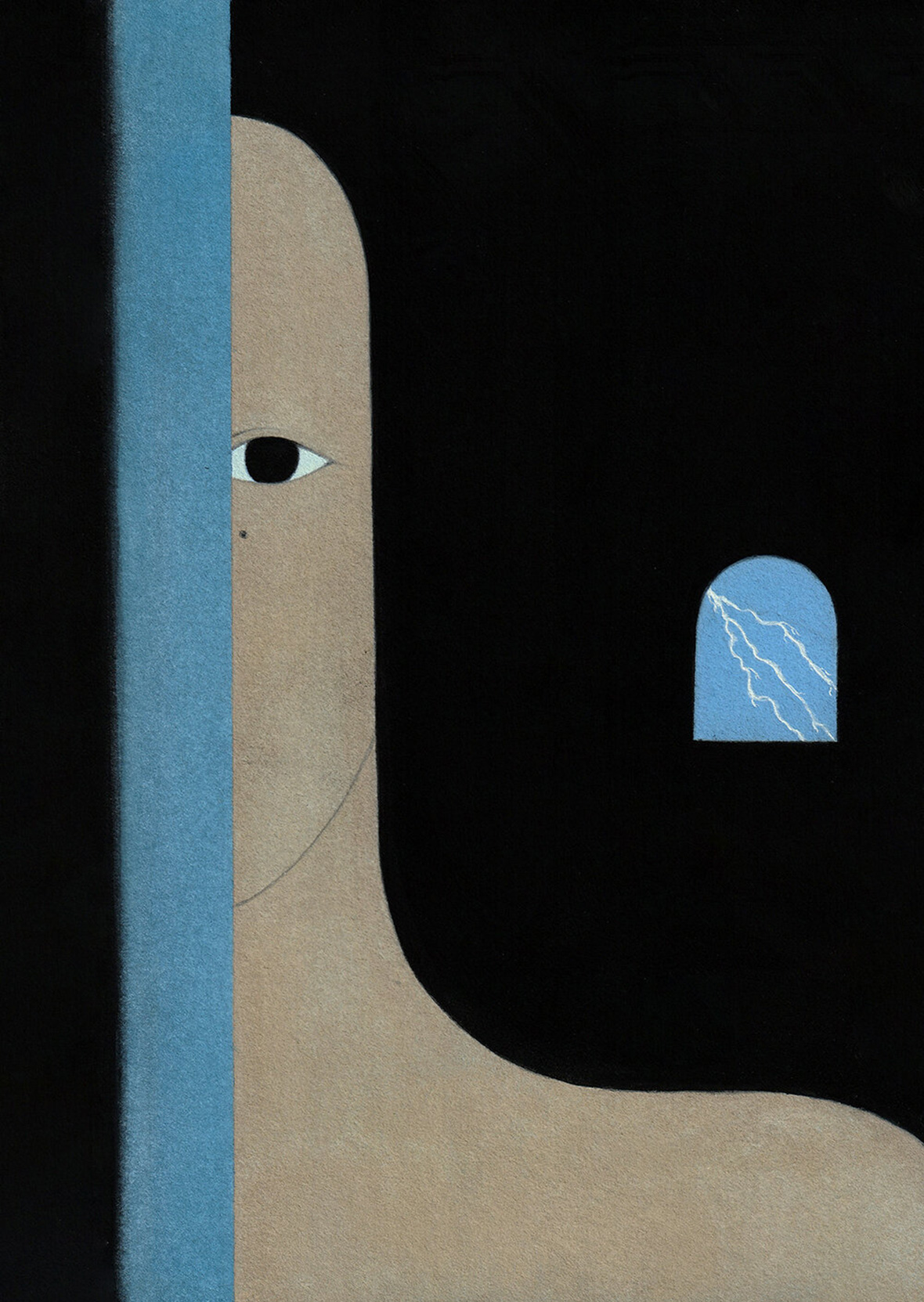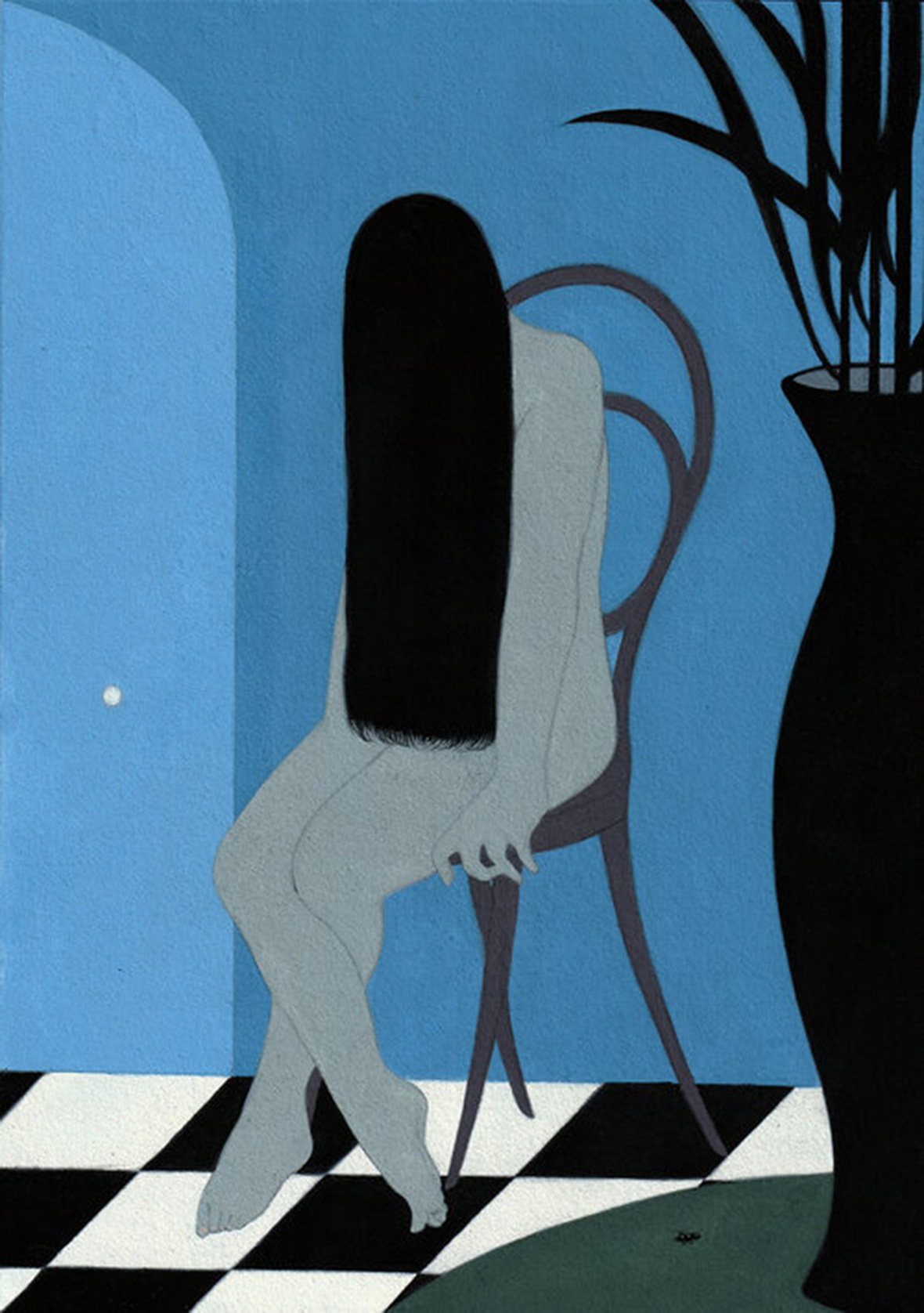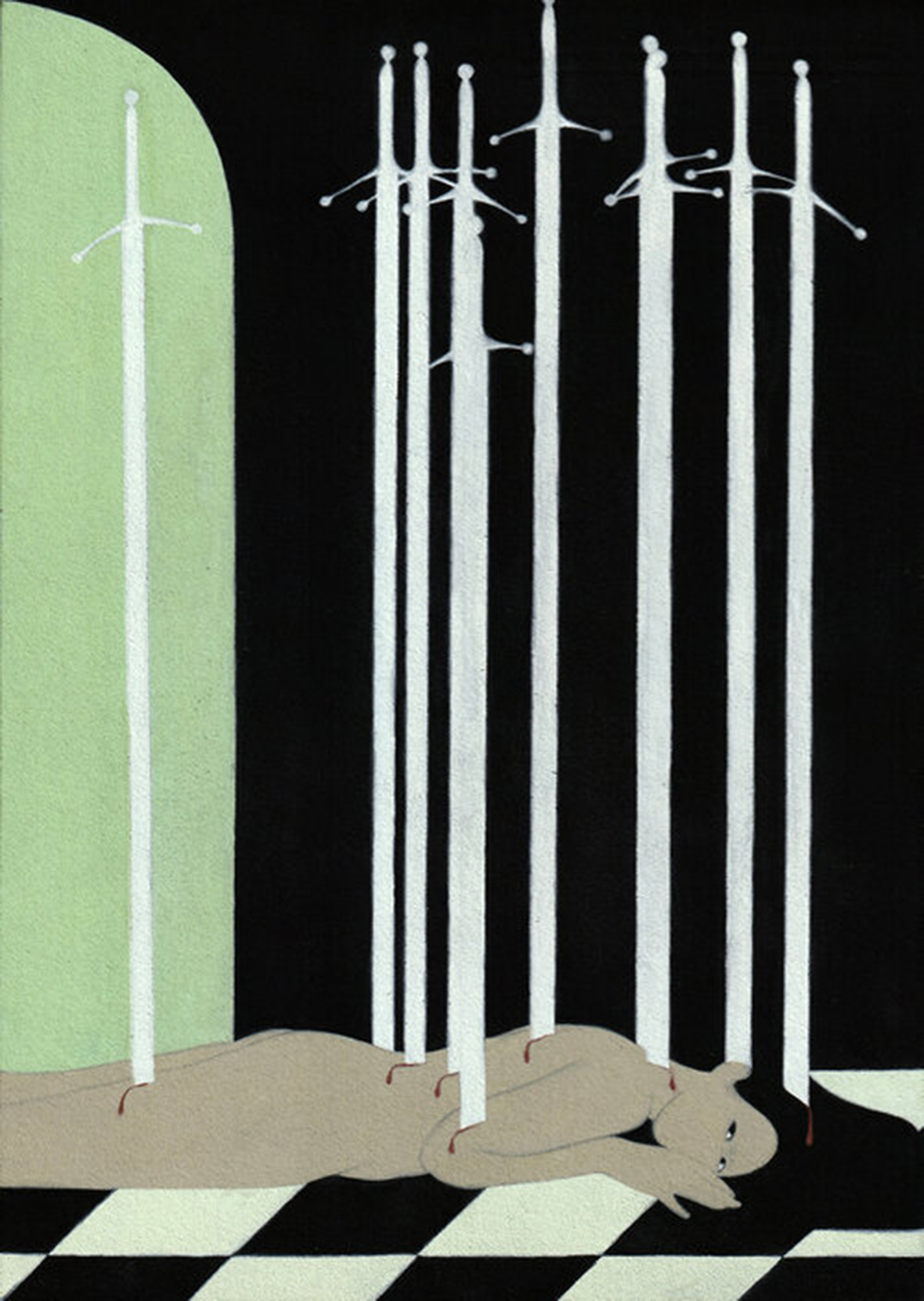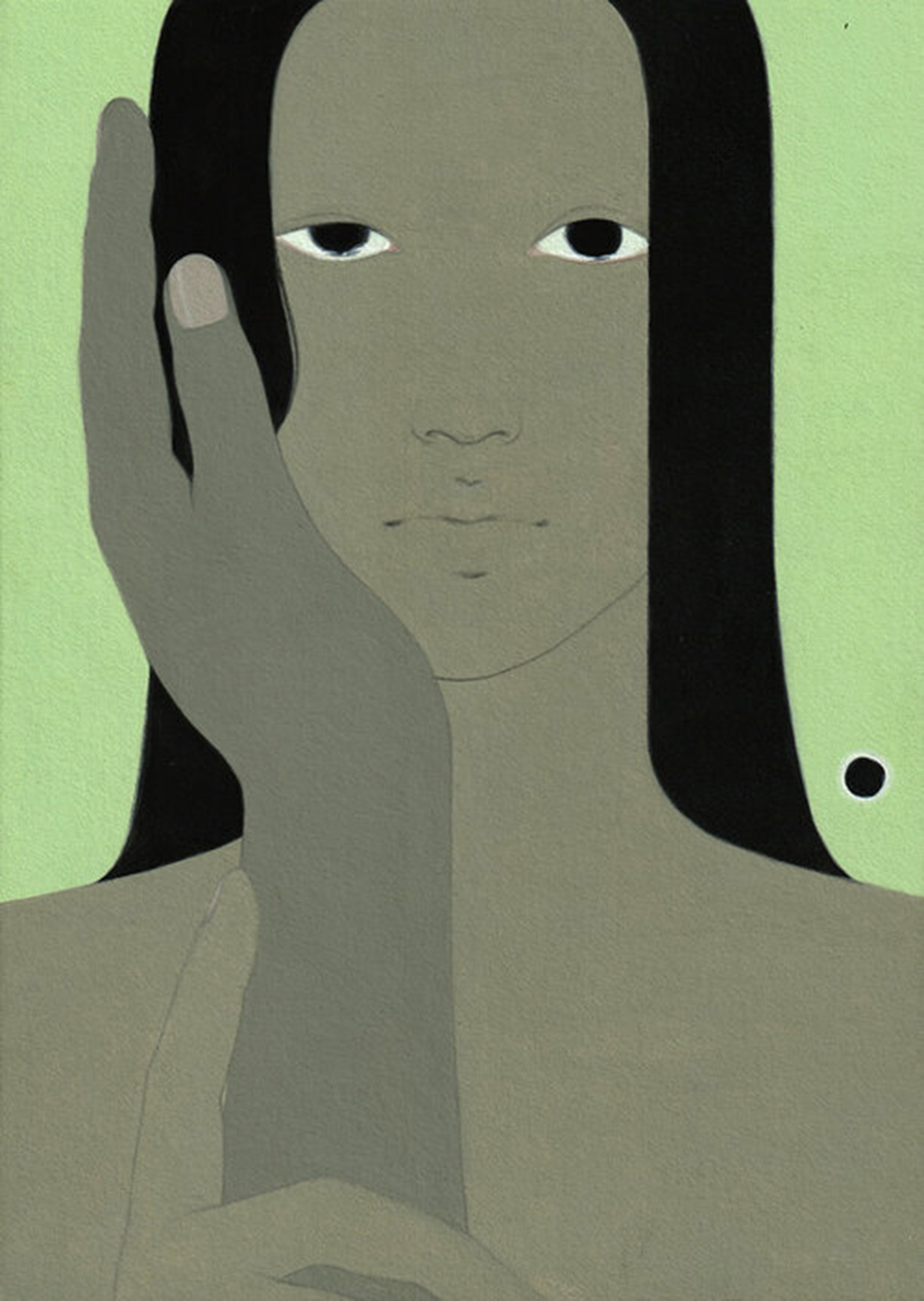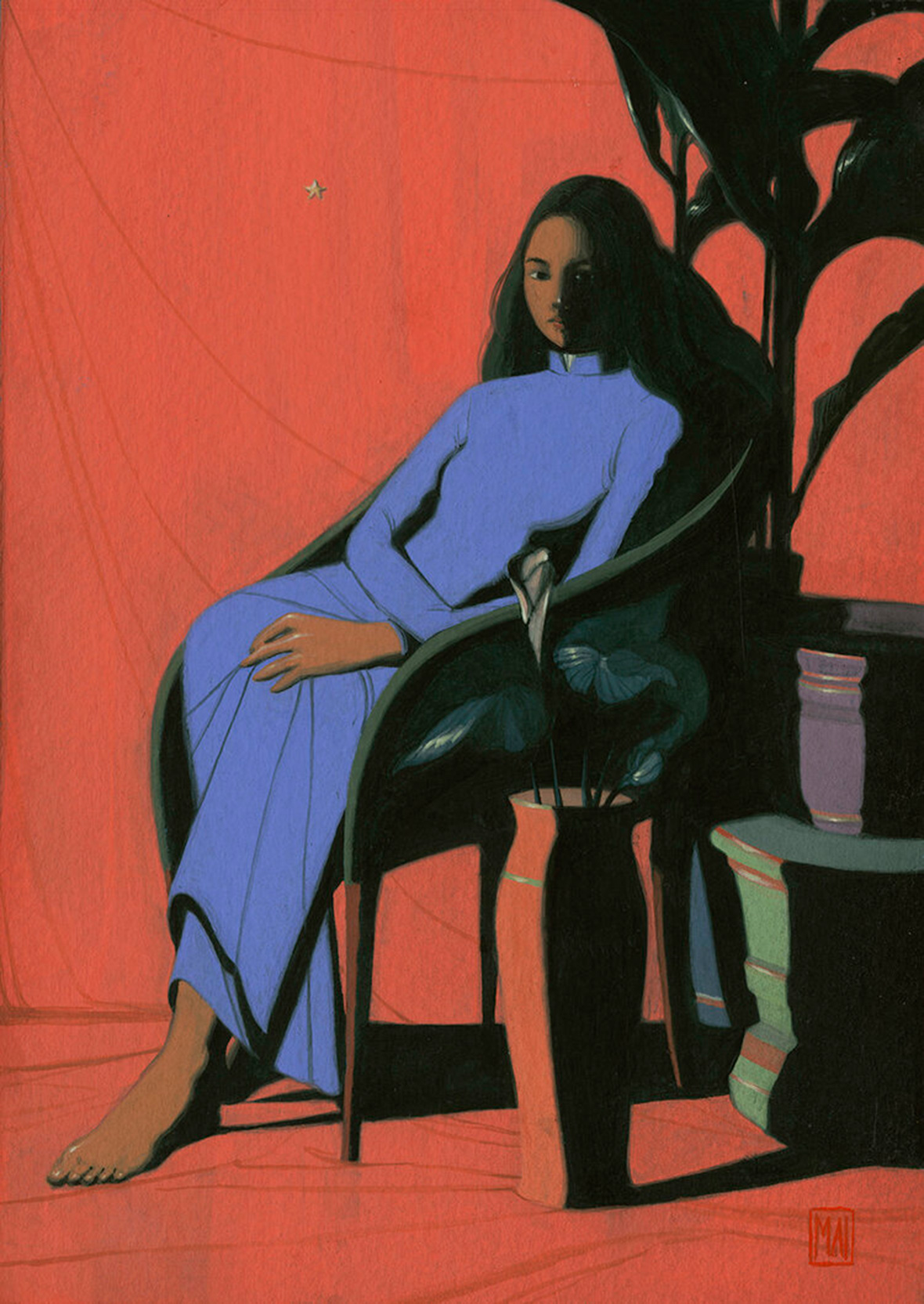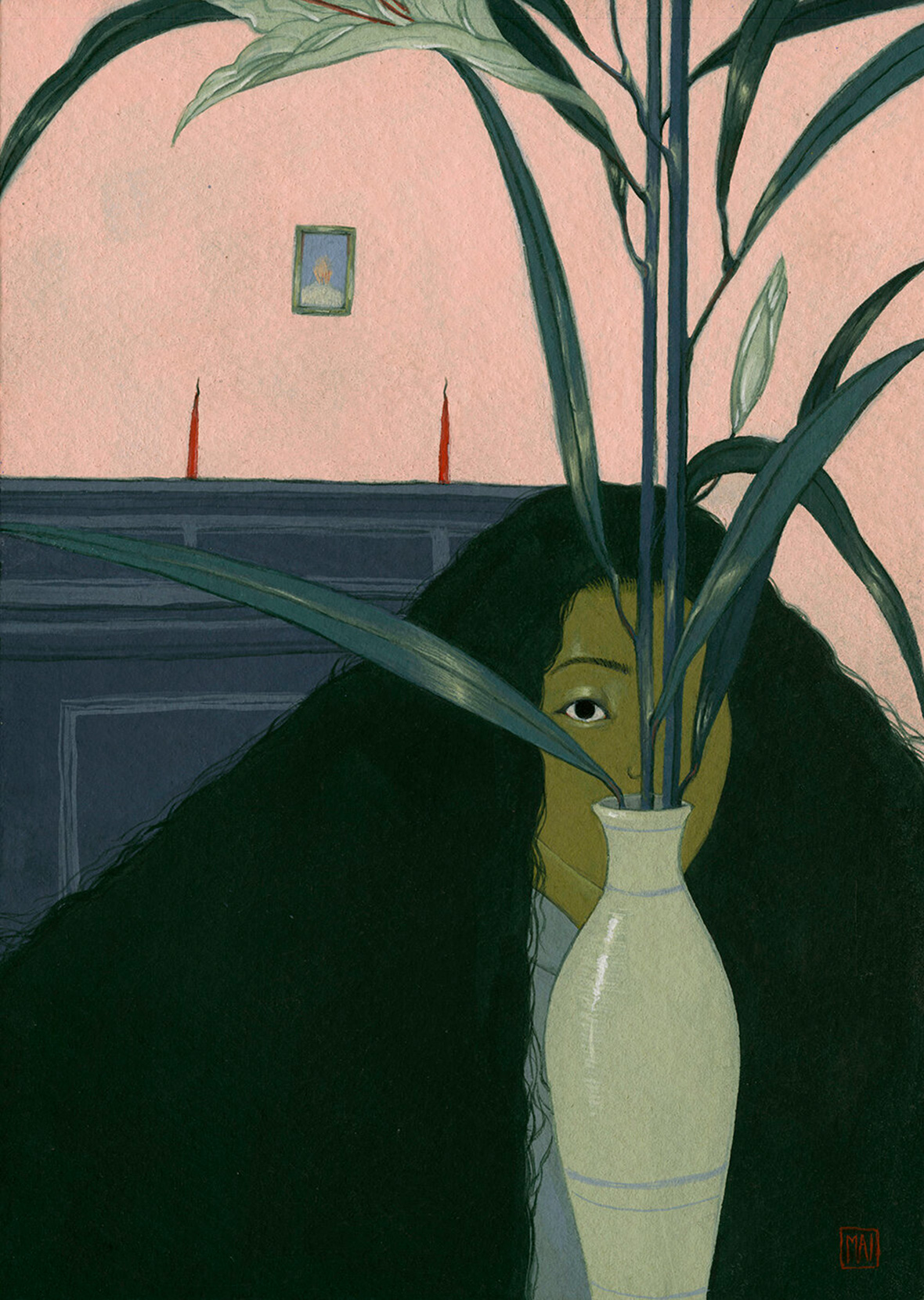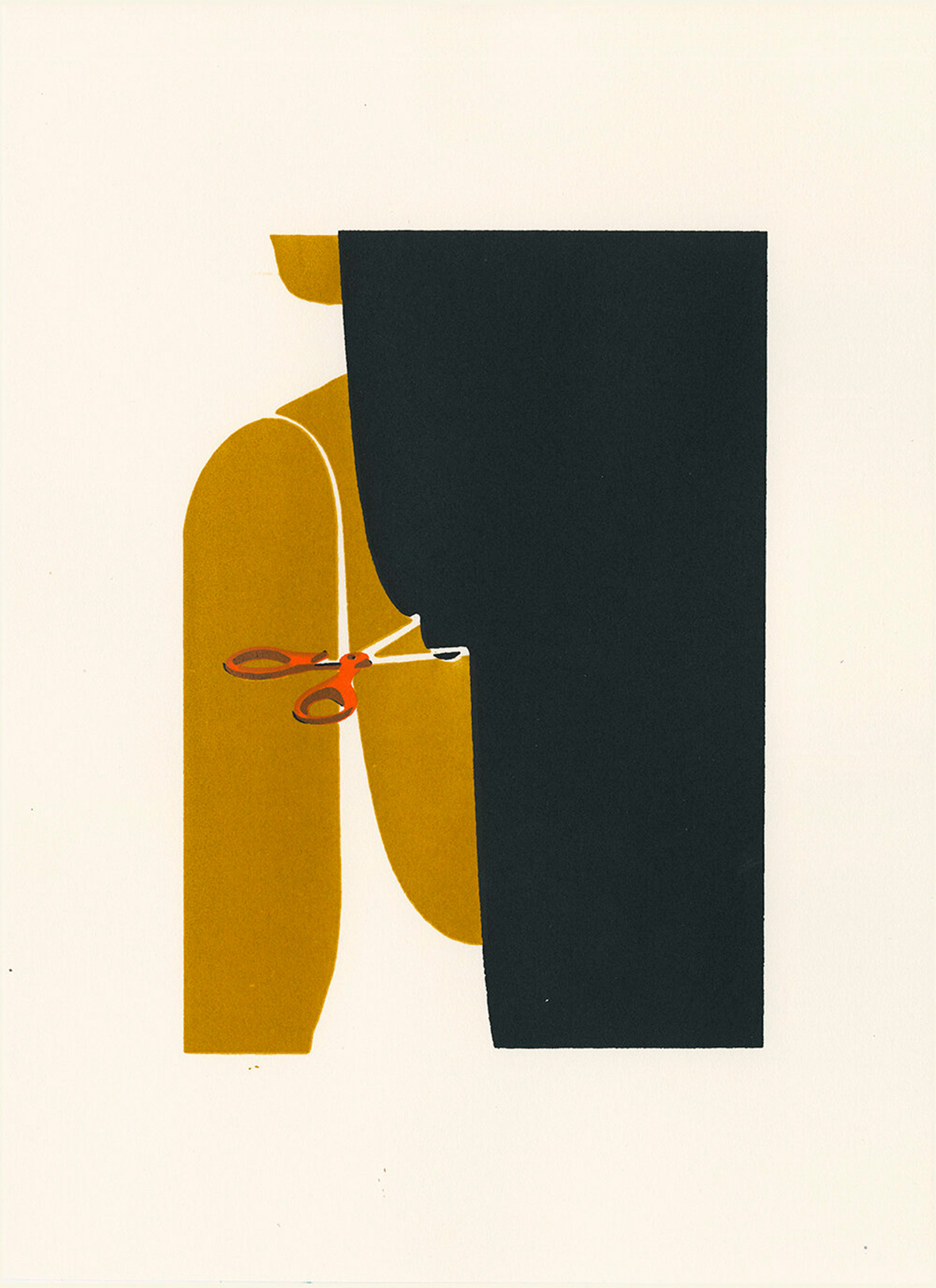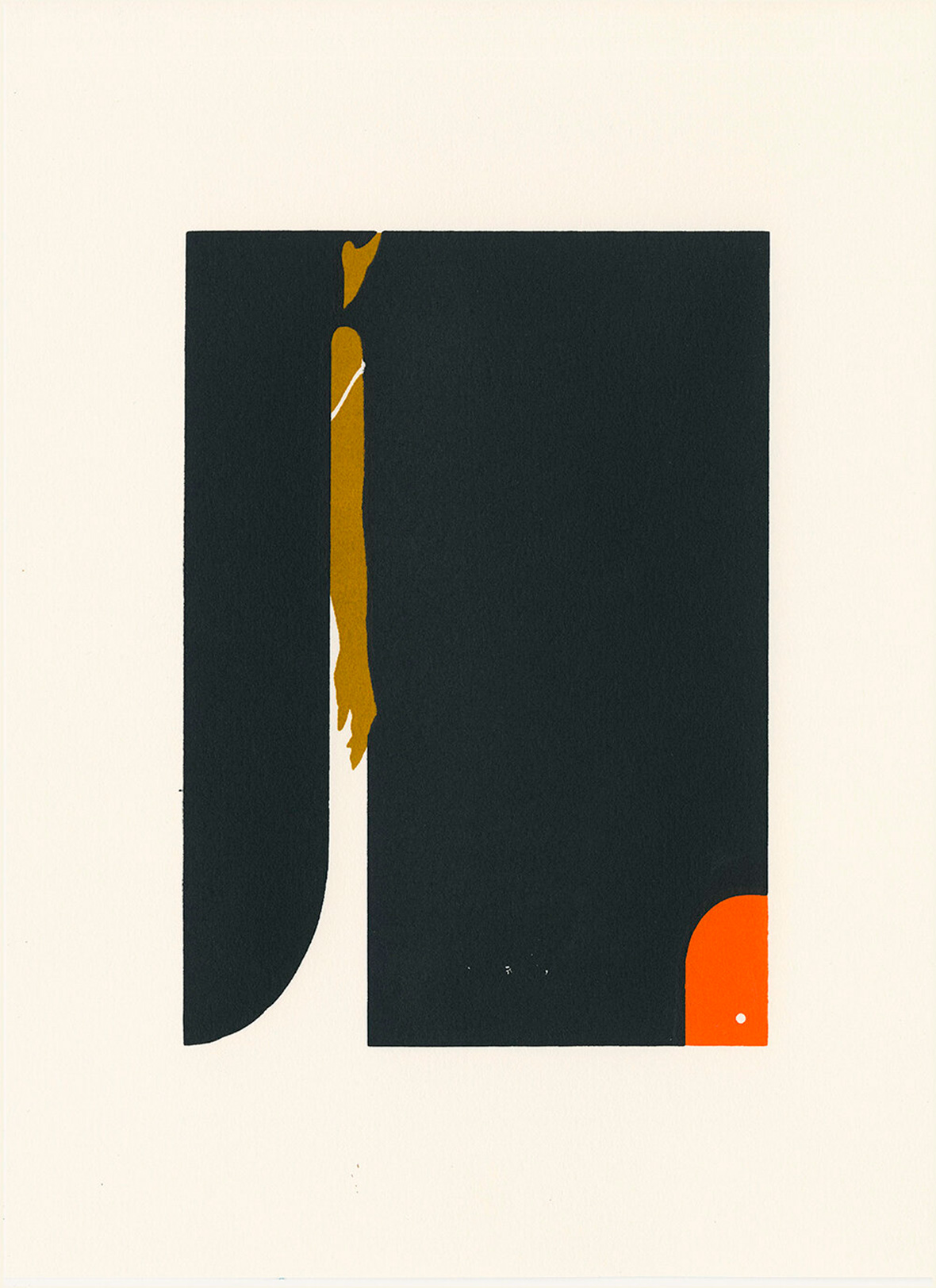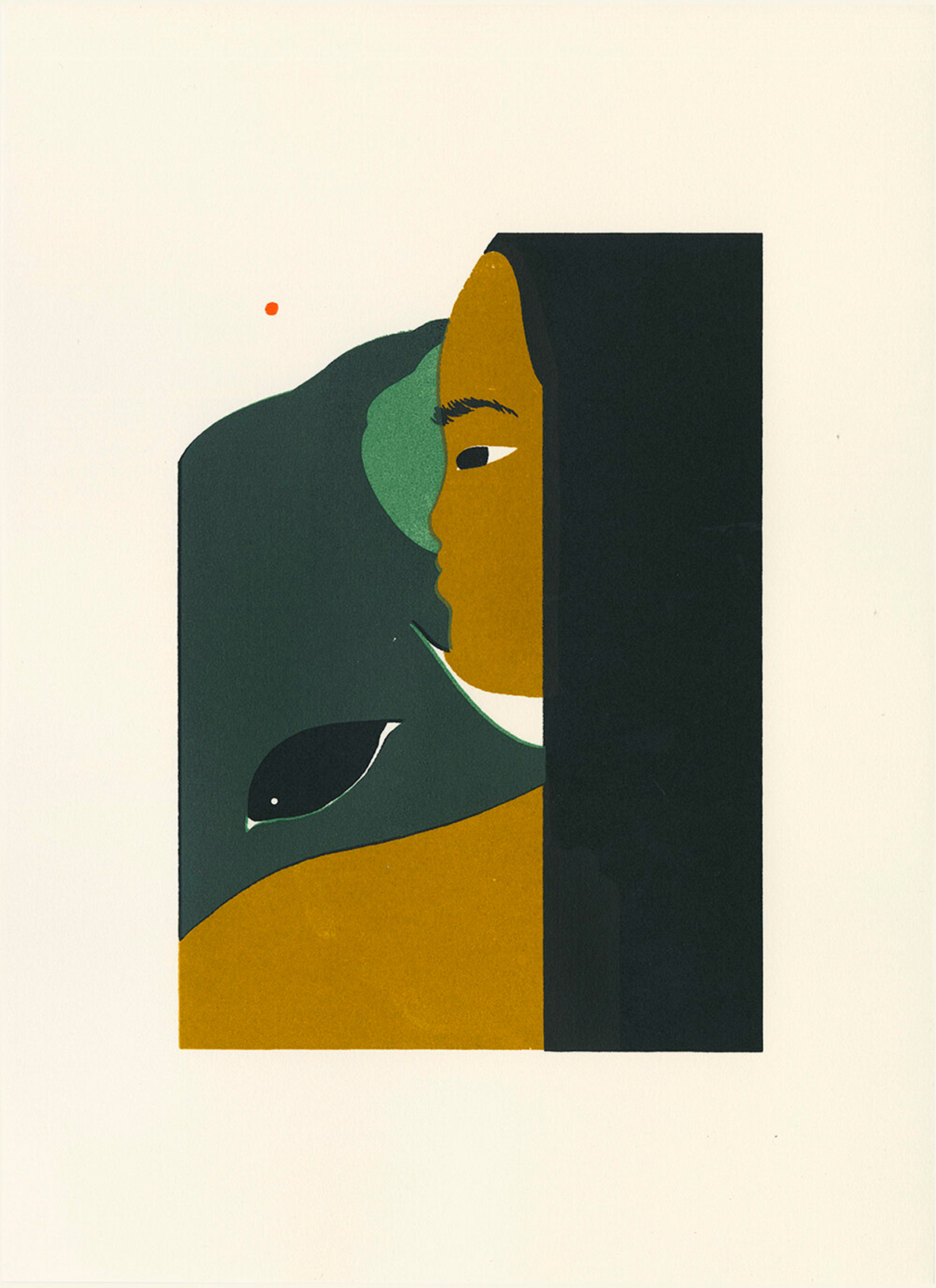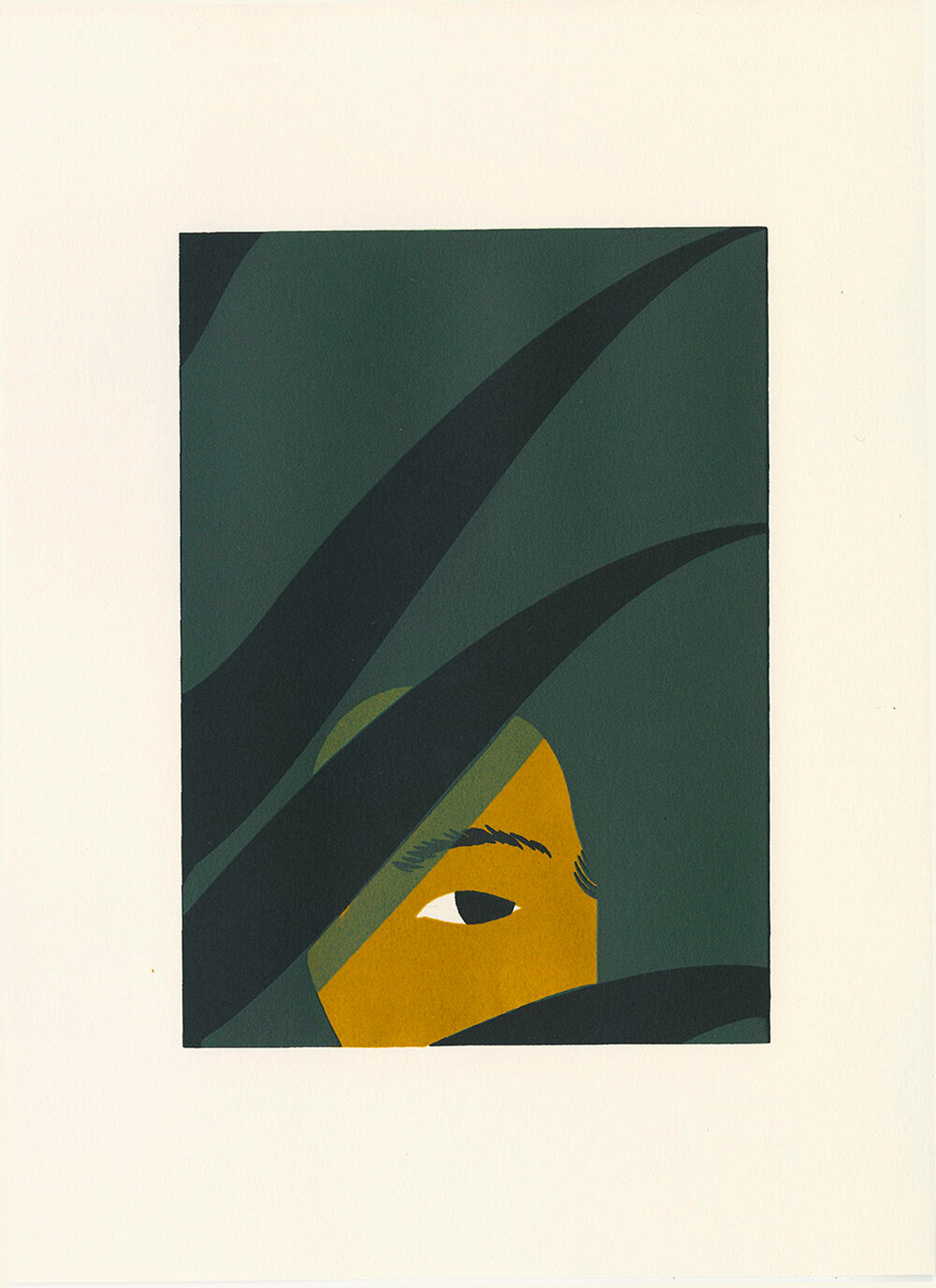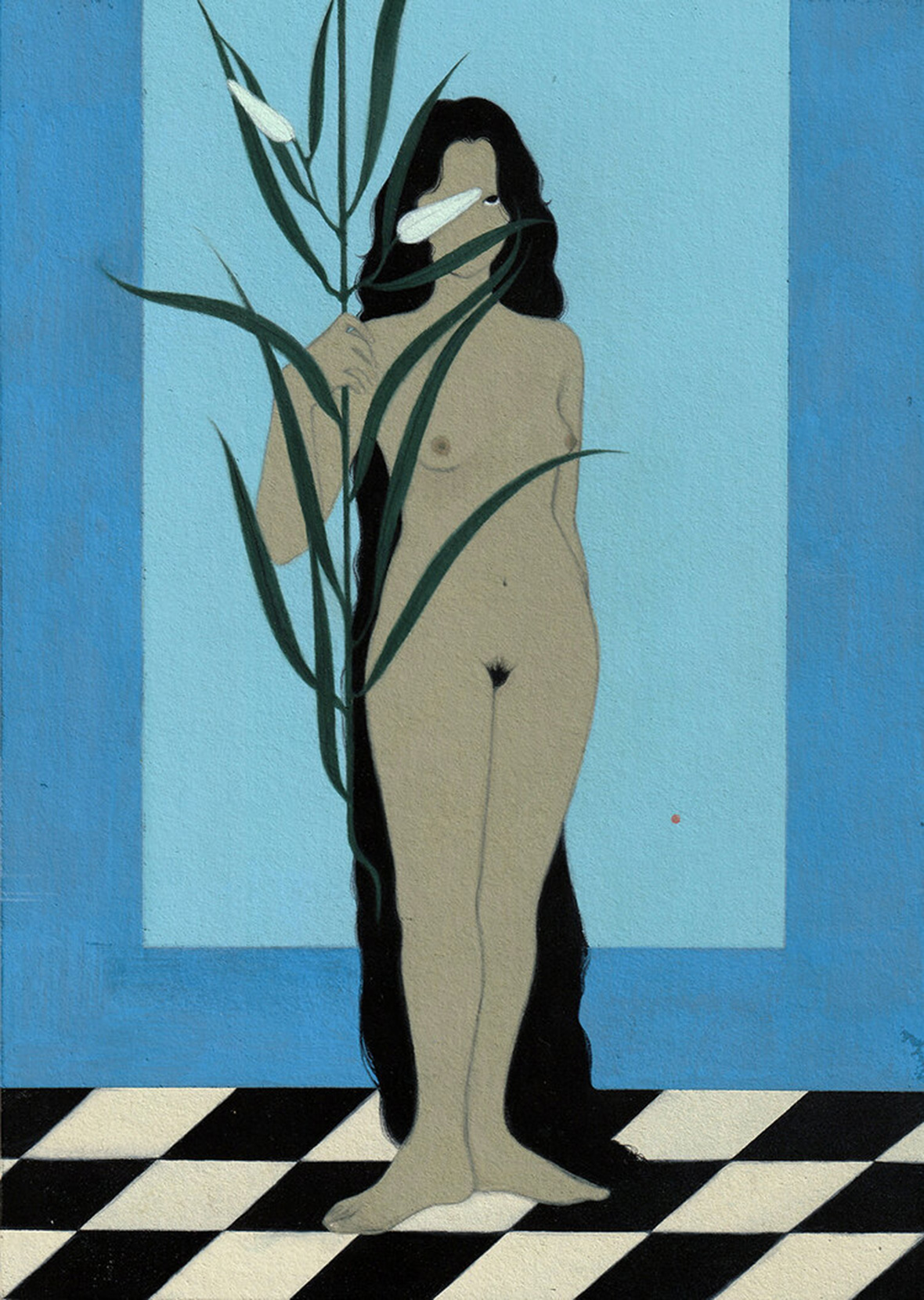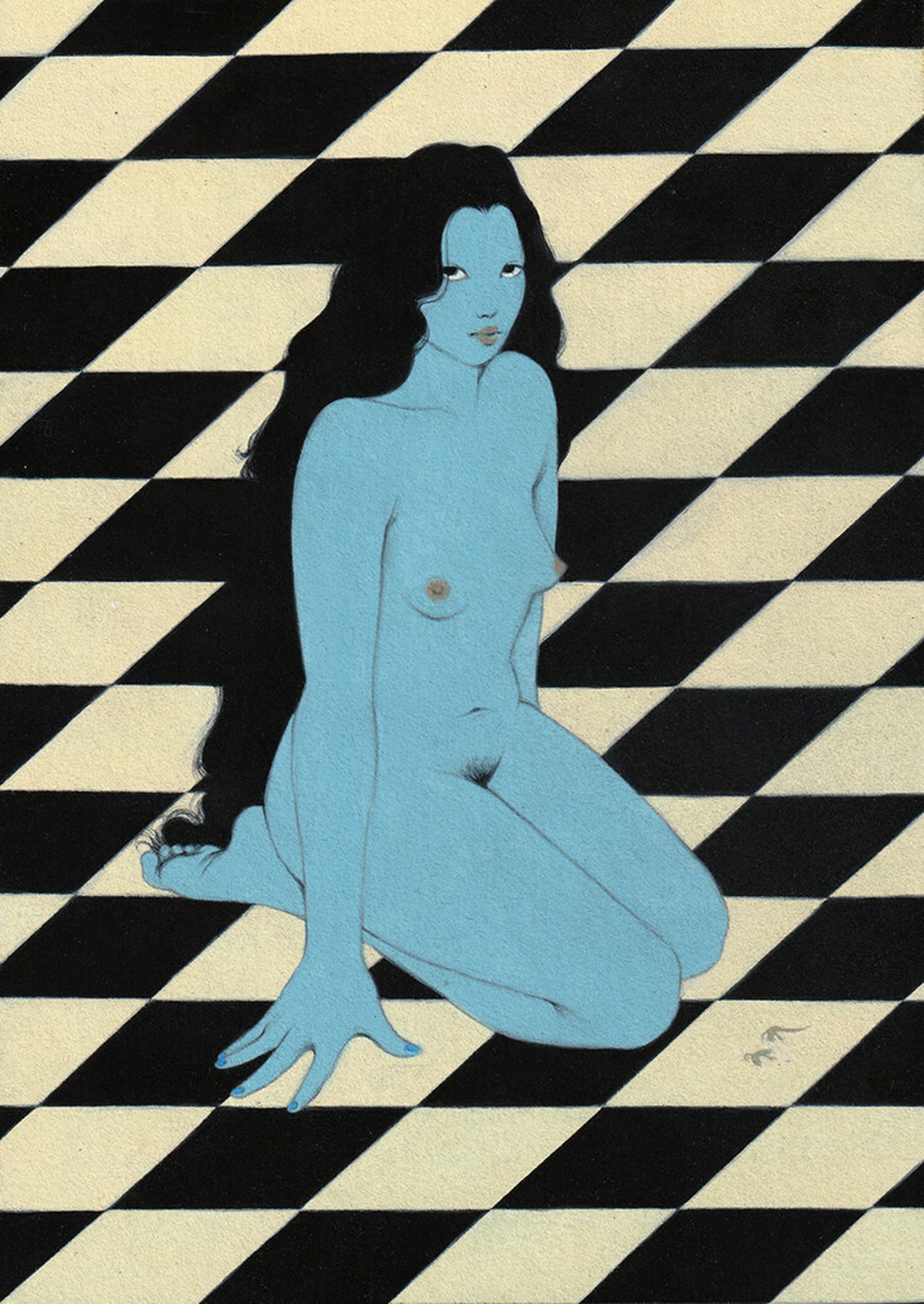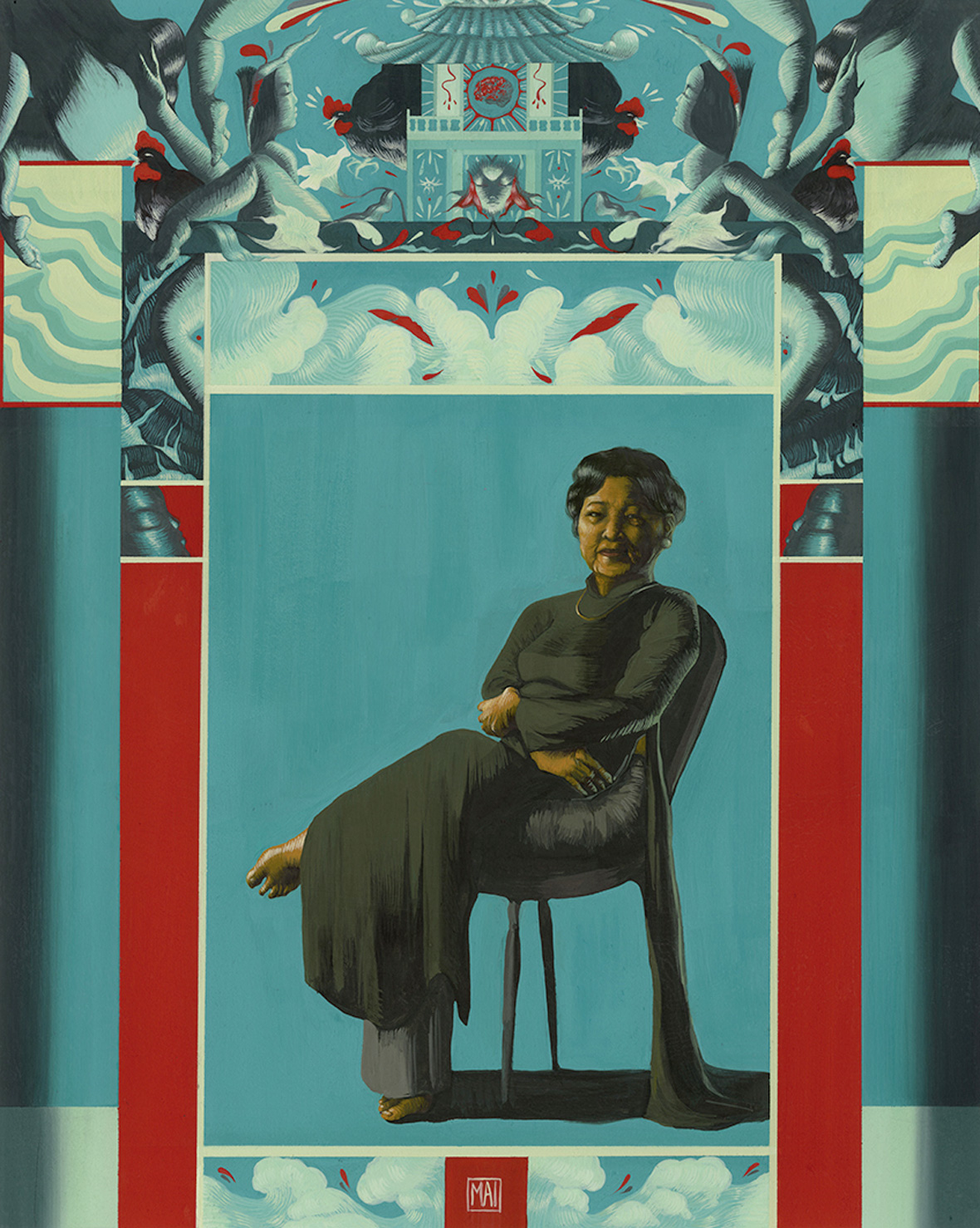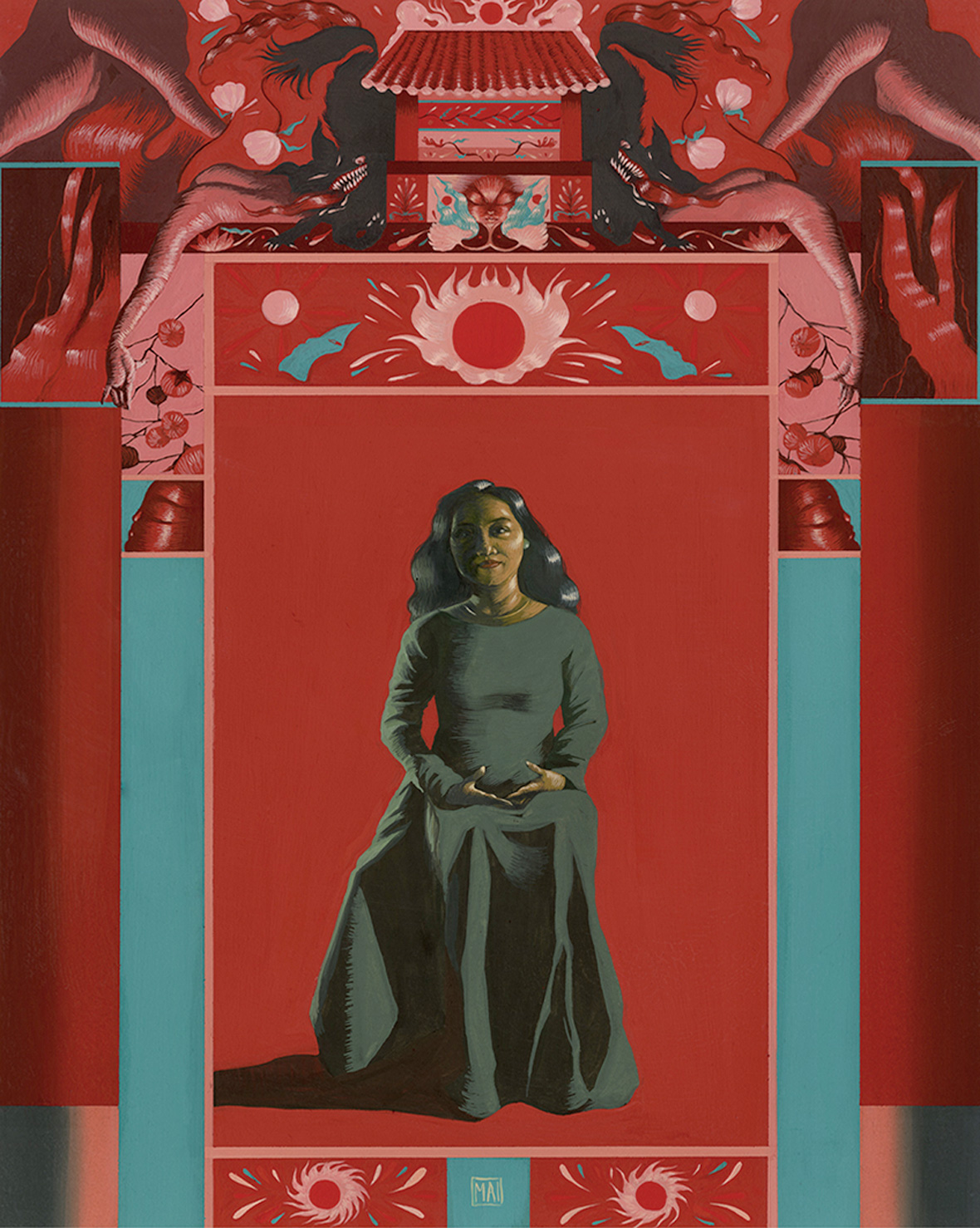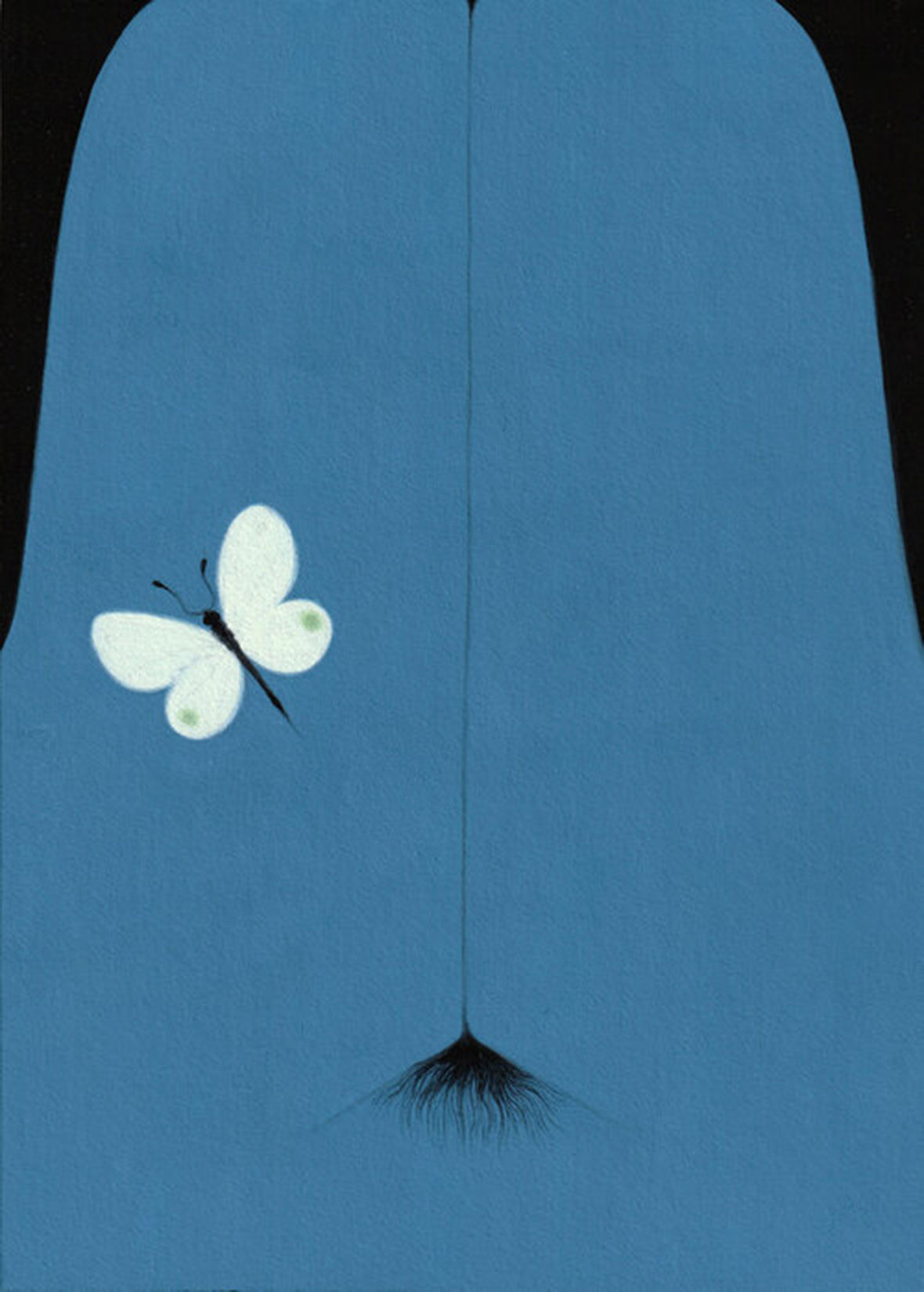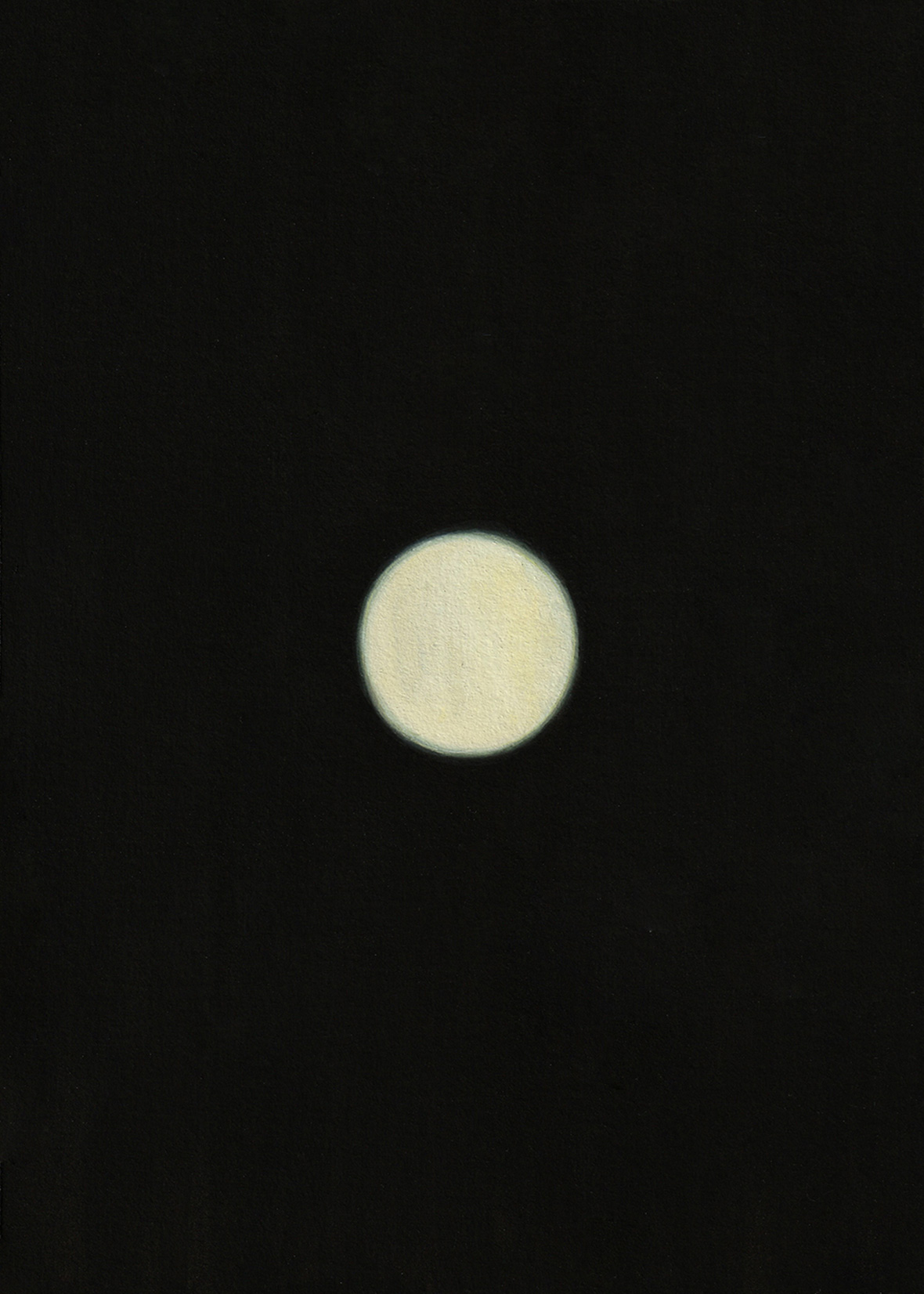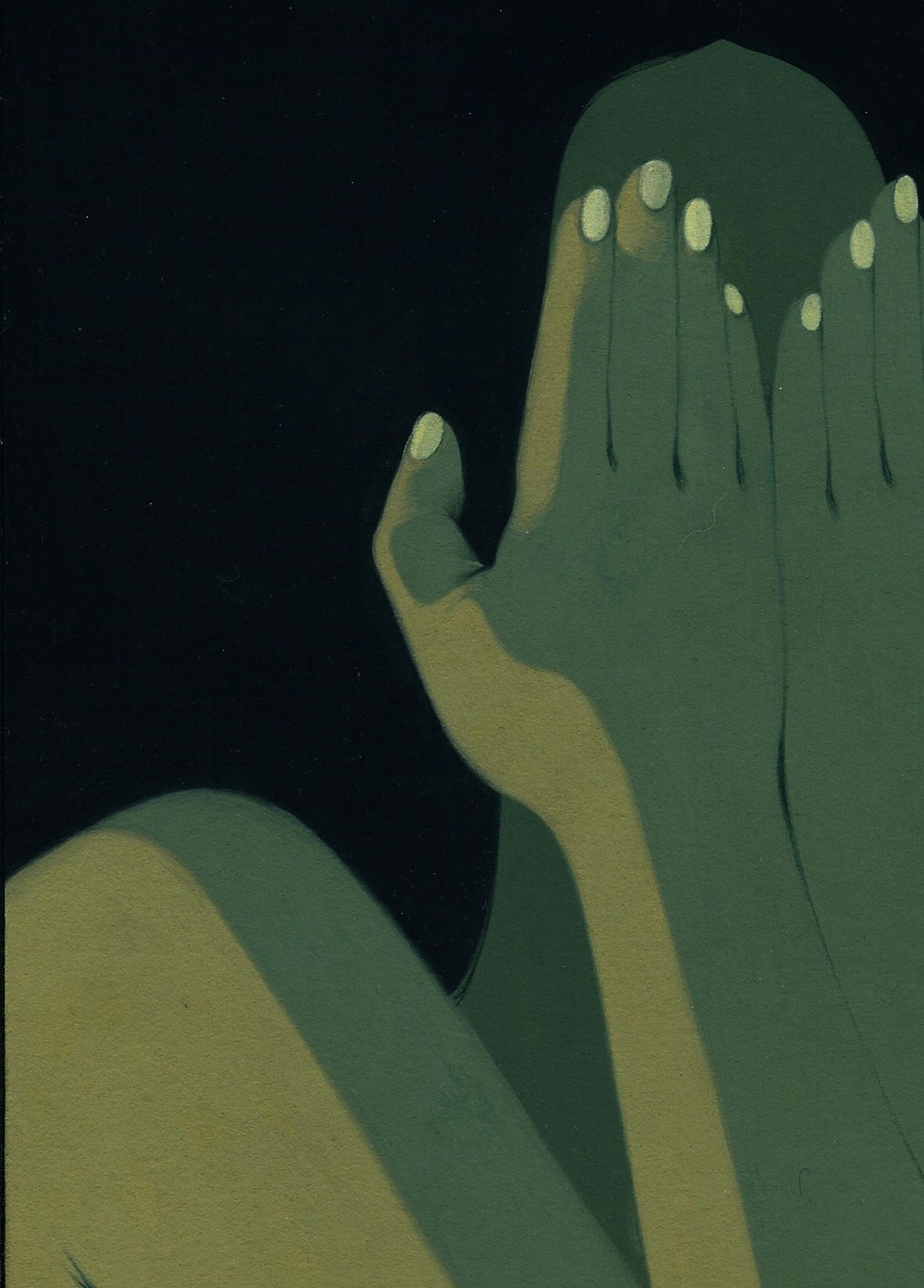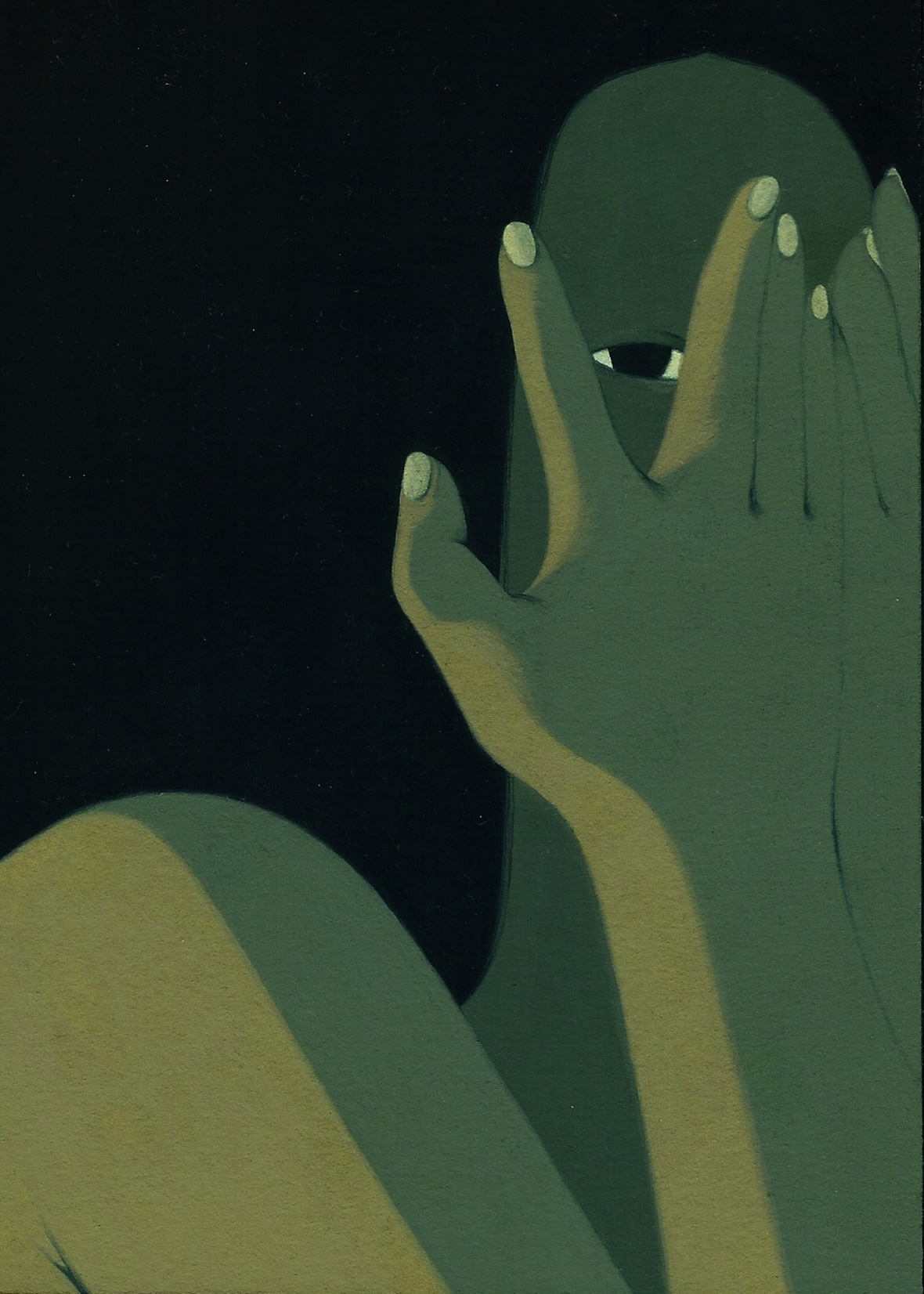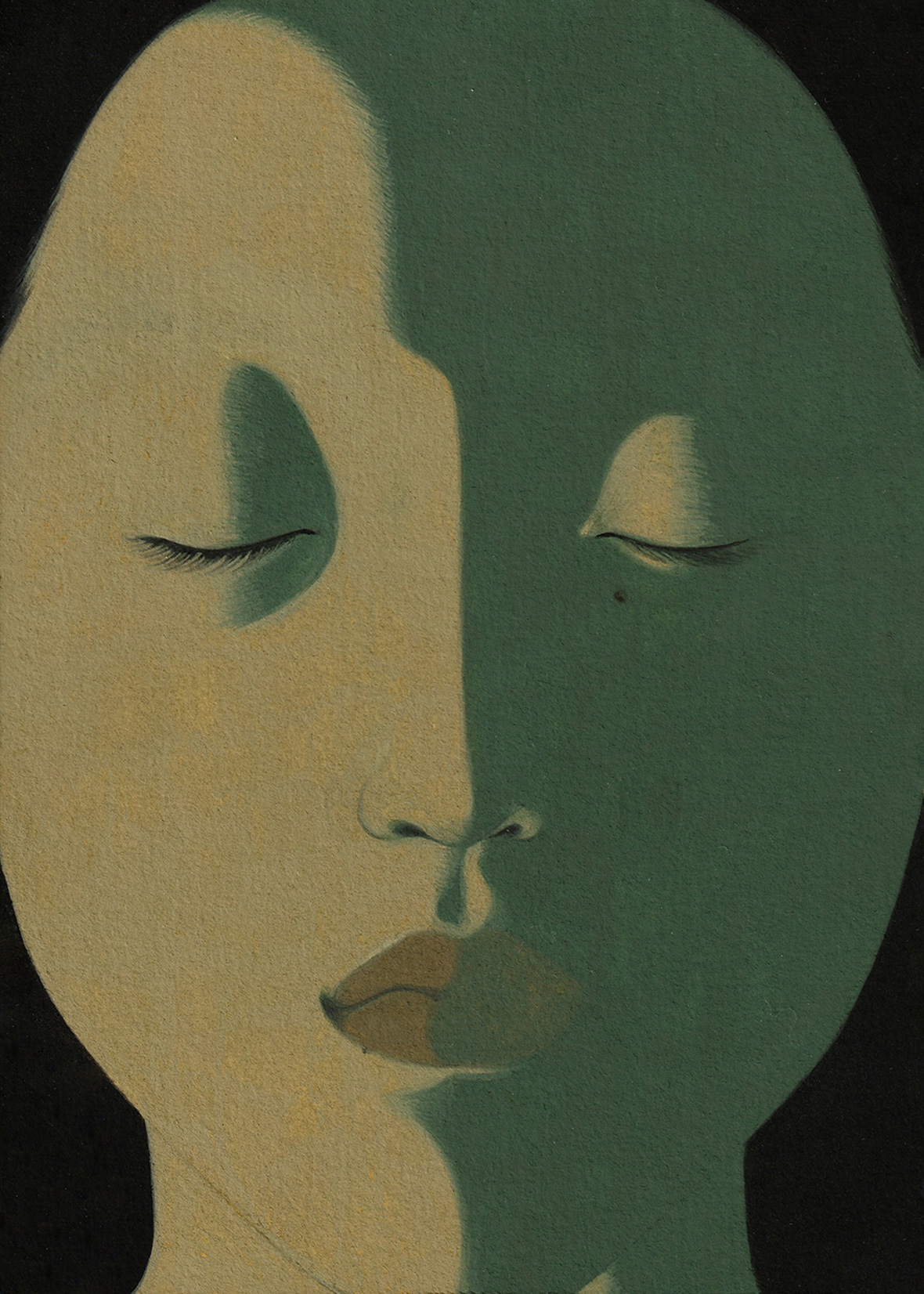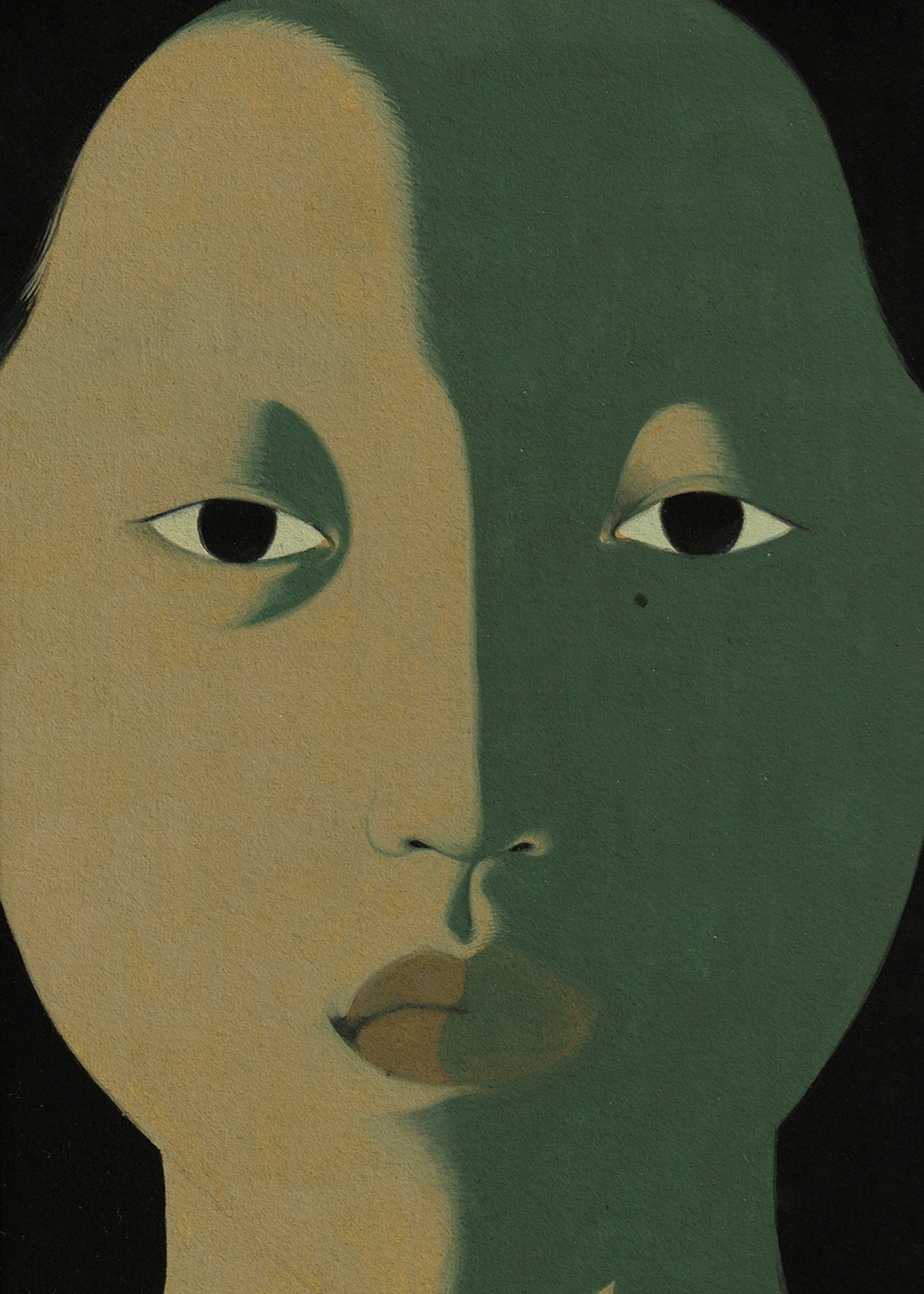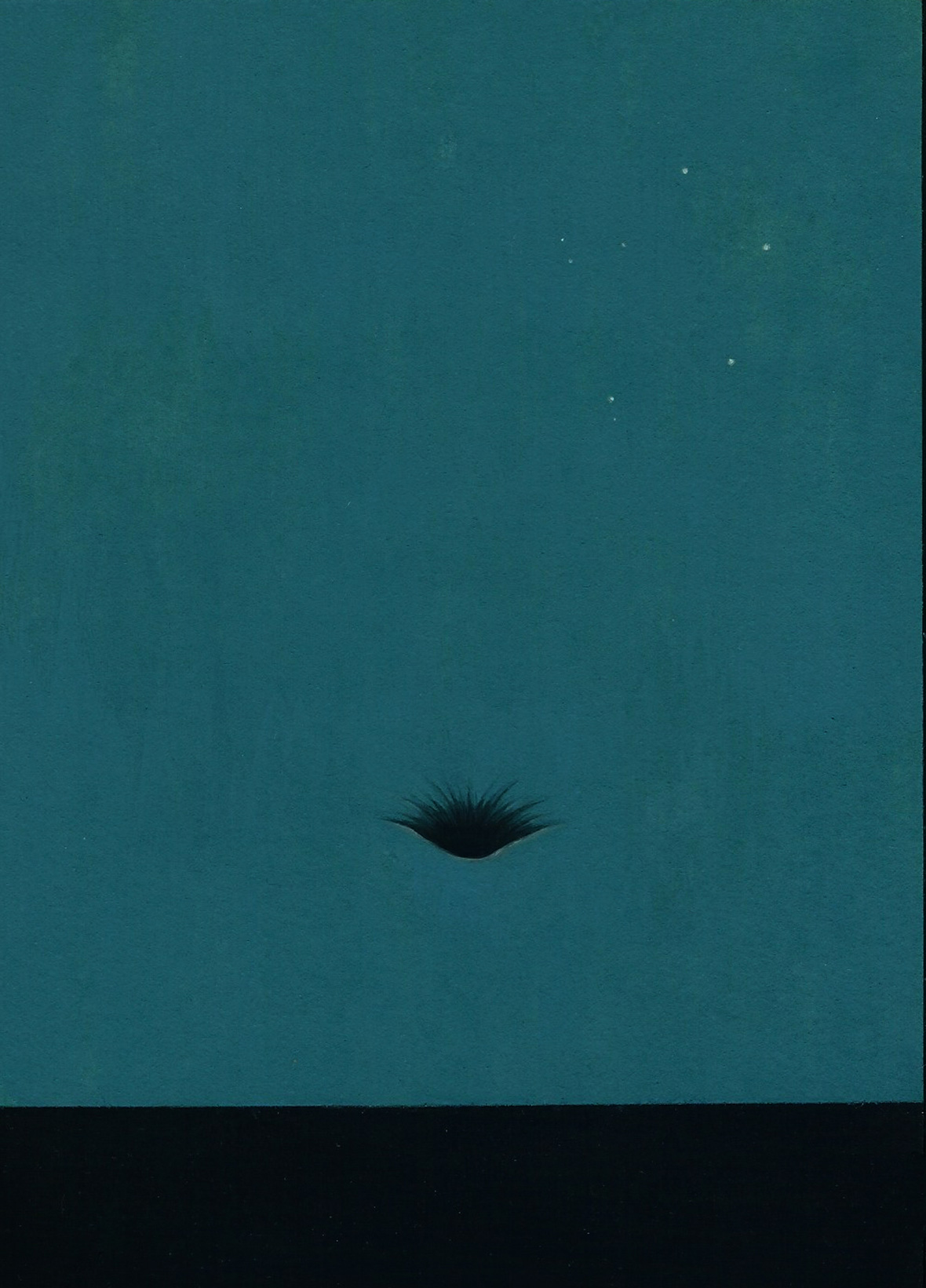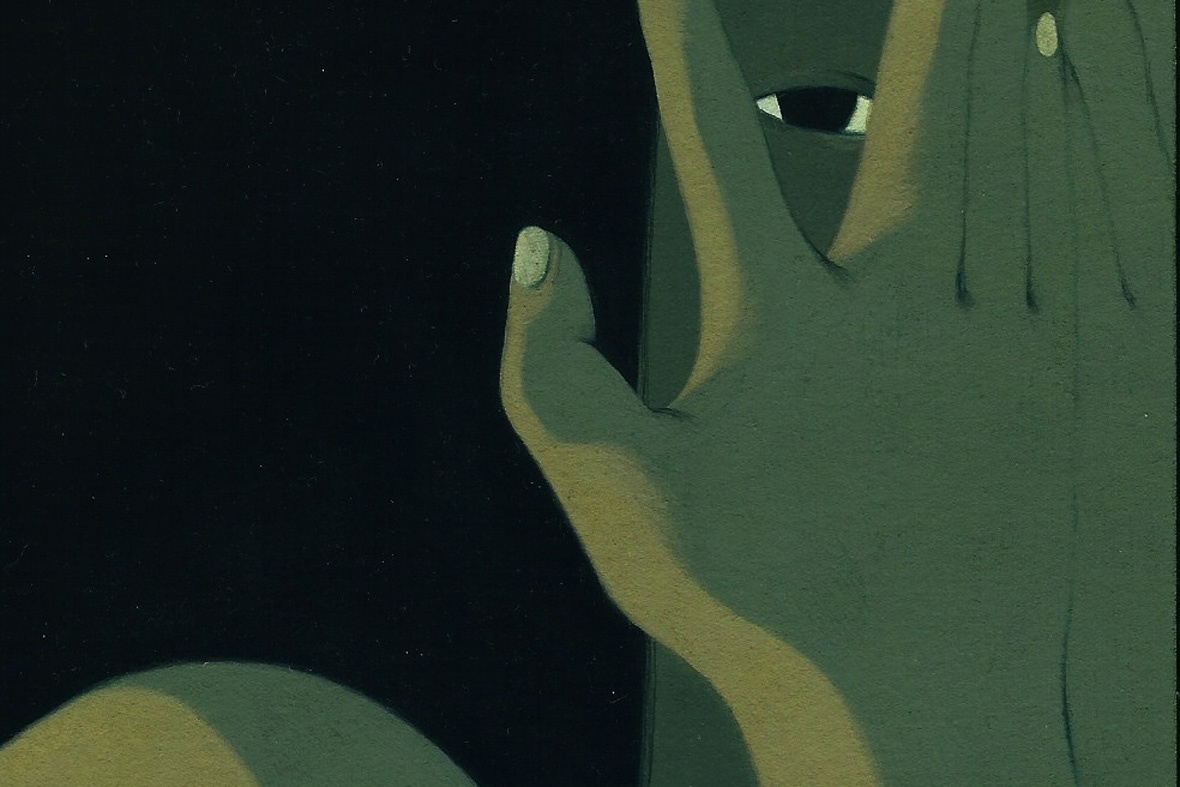
A girl looking at you, looking at her—is it voyeuristic if an invitation is implied? For Ta Quynh Mai, the feminine body is branded with the politics of looking. In this attention-deficit economy, the Vietnamese artist approaches her art with a mindful eye, calling for tenderness and patience in the act of viewing. The women she paints are soft yet brooding, exposed but never self-conscious. Within the muted palette of her canvases, a portrait of the artist emerges.
那女孩看着你、你望着她 —— 如果其中暗含邀请的意味,还能算是不怀好意的窥视吗?在越南艺术家 Ta Quynh Mai 眼中,女性身体往往被贴上了被凝视的烙印。在这个缺乏专注的时代,她以细腻的心灵洞察身边事物,来博取观众的耐心和柔肠。她所描绘的女性温柔而深沉,赤裸却坦然自若。在素雅之下,隐约可见艺术家的内心世界。
Stillness pervades Ta’s work, a reflection of the artist’s own introverted personality. She demands little from the audience but rather lets the works speak for themselves. Her laid-back attitude often contrasts the angst and restlessness that simmers beneath the canvas—the women of her paintings seem haunted by a persisting sense of discontent.
Ta typically portrays her characters in an intimate solitary. Though alone, they are never lonely—her subjects find thrill in confronting the viewer, in implicating them, and in questioning their gaze. These women live for no one but themselves. They know they’re being watched but refuse to cover up their nude bodies out of shame, and no matter whatever they may be doing, they continue without interruption. Ta’s women are uncompromising in their determination of being true to themselves. Their defiant gazes, varied skin tones, and confident body language paint a clear picture—femininity isn’t unidimensional.
收敛、克制的感觉萦绕在 Mai 的作品中,折射出她的内向个性。她不会对观众作严苛要求,而是让作品自己说话。与此同时,又有一种焦虑和不安冉冉升起 —— 她笔下的女子似乎总是被一种不满的情绪所困扰。
Mai 喜欢让笔下的角色处于私密的孤独状态,她们与观众对视,吸引又质疑观众的凝视。这些女性为自己而活,也清楚知道自己正被他人凝视,反倒不会感觉羞耻,更不会因此而遮蔽身体,她们只是不为所动地我行我素,坚定不移地做着最真实的自己,展现十足的自信。高傲的目光、多样的肤色和自信的肢体语言清晰地表明:女性气质并不单一。
In Pleasure from 2021, one of Ta’s iconic blue girls cuts across her palm with a sword as she kneels nakedly on the tiled floor. In Ten of Swords, long claymores skewer another woman laying on similar tiles. The viewer is made to bear witness to these sacrificial rituals, implicating themselves in the privacy invasion of these women. Eerily enough, the impaled woman turns her head to confront the viewer. As a viewer, one is involuntarily situated within a site of a soundless massacre. Yet, they cannot take their eyes off the subject, a sadistic need to continuously decipher what she is feeling, what she is thinking, and what she is desiring.
Though it may be easy to mistake in certain paintings, Ta’s women are not hiding from the world, just merely disappointed by it. I Look For Empathy in the Wrong People from 2019 shows a girl with long, dark hair peeking out from behind a vase—no one has what she needs, yet she is still compelled to observe them.
Red Blood Spill from the same series is one of Ta’s more popular works. In it, a woman dressed in an immaculate blue ao dai is seated in a chair against a red backdrop, with half of her face enveloped by shadows. It’s not clear what she’s waiting for, but her gaze seems to carry a predatory hostility, one of complete control. The woman is much like a huntress, wielding a piercing stare that renders viewers defenseless.
蓝色女孩是 Mai 作品中的标志性元素。在 2021 年的作品《Pleasure》(满足)中,蓝女孩浑身赤裸地跪坐在瓷砖地板上,她正用剑划过自己的手掌心;在《Ten of Swords》(十把剑)中,数支高耸的苏格兰笼手剑笔直地插在地上的女人,地板铺着和《Pleasure》中一样图案的瓷砖。观众被迫见证这些祭祀般的仪式,无意间入侵这隐私的领地。更令人不寒而栗的是,被剑刺穿的女人还转过头来,望向观众。观众不由自主地置身于一个无声的杀戮现场。然而,他们无法将目光从画中的女性角色身上移开,就像嗜虐者一样,想要破译她的感受、想法和渴望。
你或许会误以为这些作品想要表达对现实的逃避,但 Mai 其实只是对现实世界太过失望。在创作于 2019 年的《I Look For Empathy in the Wrong People》(我在错误的人身上寻找共鸣)作品中,一头黑色长发的女孩从花瓶后直勾勾地望向观众,一副看透凡尘的失落面孔,极具压迫感。
同系列的《Red Blood Spill》(血溢)是 Mai 最受欢迎的作品之一。画中,身着纯蓝色奥黛(越南的传统服装)的女子坐在靠椅上,她身后铺满了血红色背景,让她的半张脸笼罩在阴影之中。虽然不清楚她在等待什么,但目光透露出掠夺者的傲慢,彰显着绝对的控制欲。她更像是一名猎手,以锐利的目光,让观众束手就擒。
The power and confidence of Ta’s women are apparent even in her titles, such as You Are Not the Sun, I Am, I Set the Moon on Fire Because She Wouldn’t Wake Up, or She Bloomed at the Dead of Night. She attributes this reverence for words to her love of poetry, an interest passed on by her grandmother. Title ideas come from tarot cards, astrology, or just Ta’s stream of thoughts, serving as artful extensions of the paintings. Through both art and poetry, Ta seeks to understand no one else but herself.
This philosophy perhaps best captures the essence of Ta’s approach towards art—if you miss it, she won’t fault you. But if you come across her works, you’re expected to offer forth a scrutinous eye. In their stillness, Ta’s women aren’t hiding but are simply uninterested in revealing their full selves to a world they’re disillusioned by. Her series You’re Not the Sun, I Am features women in minimal snippets, showing only close-ups or partially visible figures caught in thin slivers of light. Paintings such as Arch and Hair reject the audience of a full view as if stating that viewers are not entitled to their privacy and what they do out of sight.
Mai 笔下女性的坚强与自信也体现在作品的标题中,比如《You Are Not the Sun, I Am》(你不是太阳,我才是)、《I Set the Moon on Fire Because She Wouldn’t Wake Up》(我点燃月亮,因为她不愿醒来)和《She Bloomed at the Dead of Night》(死夜下的盛放)。受祖母影响,Mai 很喜欢诗歌,对文字有着特别的嗅觉。作品标题作为画作的延伸,有的取材于塔罗牌、占星术,有的则是 Mai 内心的写照。她试图在艺术和诗歌的世界里认识自我,而不是其他人。
淡如水,是 Mai 创作的核心,这些颜色好像在说:如果你错过了我的作品,我并不会责怪你;但既然你选择要看,我希望你仔细观看。Mai 画中的女性沉默不语,却从不试图躲藏,她们只是不想对一个失望彻底的世界坦述自我。在《You’re Not the Sun, I Am》系列中,女性角色仅以片段的形式出现,譬如某个部位的特写或缝隙中隐约可见的身影,例如《Arch》(曲)与《Hair》(发)等作品都拒绝向观众展露全貌。这种蒙太奇式的创作方式,仿佛在告诉观众 —— 你无权进入女子的隐私空间、无权了解她们的一举一动。
Ta subtly subverts the viewer’s understanding of nudity through an almost playful take on the matter. In the 2019 paintings Aries Rising and Scorpio Venus, she features nude females, but the former sees the subject centered with an unobstructed view, while the latter sees the woman attempting to cover up her body with a slender floral stalk. Just because the viewer has seen these women in the nude, it does not mean they know anything else about them. In these paintings, the women’s gazes seem to question the viewer’s intentions, prodding them to reconsider their notions of nudity and the female body. Ta’s women are fully aware that their bodies are being watched. Yet, there is no trace of embarrassment. After all, it is the viewer who is implicated as an intruder.
Far from coquettish, Ta’s women are conquerors and liberators. Their nudity is presented in a completely non-sexual context; these women are engaging with their quintessential femininity with a sagacity. Ta believes that sensuality should not be mistaken for promiscuity, and sexuality should not be mistaken for consent. Whether clothed or nude, the women on her canvases are the ones in charge—their bodies belong to no one.
对于赤裸,Mai 习惯以巧妙的方式呈现。在 2019 年的作品《Aries Rising》(上升白羊)和 《Scorpio Venus》(天蝎爱神)中,女性们赤身裸体,前者一览无余地坦露身体,后者则试图用纤细的花茎遮挡身体。观众看到了女子的裸体,但这并不意味着他们真的了解她们。这些作品中,女子的眼神似乎在质疑观众的意图,促使他们重新思考关于裸体和女性身体的概念。Mai 作品中的女性很清楚自己身体正被他人凝视,然而她们丝毫不觉得尴尬。毕竟,真正的始作俑者是观众自己。
Mai 作品中的女性并不卖弄风情,相反,她们往往关于征服和解放。她们的裸体置于一个与性欲无关的环境中;她们的眼中充满聪慧、睿智与克制的气息。Mai 认为,性爱不应被误认为是滥交,性感也不应被视为性同意。无论是穿着衣服或赤身裸体,她画中的女性都是自己身体的主人,她们的身体不属于任何其他人。
Ta relies on art to provide a space where she can express herself safely “without guilt.” When asked about this “guilt” that art frees her from, Ta confesses that she’s always felt uncomfortable in her self-expression, as it is often affected by outside influence. In her everyday life, Ta describes herself as a mirror, an amalgamation of different people that she meets. But in art, she’s not responsible for anyone’s thoughts and feelings but herself. Her art is not one of appeasement. “In art, I can be private, and when it’s private, I am free,” she says.
This preference for isolation does not necessarily insulate the artist or her female protagonists from the world. Rather, a part of Ta’s magic is her threading of themes across her canvases, almost so that her subjects seem to be in conversation with one another. United, these women communicate through fearless glances and through their ability to immediately disarm viewers. In their silence, the women of Ta’s art meditate on the complexities of womanhood, on what they have learned from the generations of women before them.
借助艺术的形式,Mai 得以“毫无愧疚”地表达自己。当被问及艺术让她所摆脱的这种“愧疚”到底是什么时,Mai 解释道,一直以来她始终无法坦然地表达自我,总会受到外界影响。她觉得日常生活里的自己就像一面漂泊于世的镜子,总在包容遇到的不同人。但在艺术创作时,除了自己,她不需要顾虑任何人的想法和感受。她的艺术不需要妥协与退让。“在艺术中,我可以有自己的世界;而在这个私密的世界里,我是自由的,”她说道。
但喜欢独处并不意味着这位艺术家及其笔下的女性角色与世隔绝。相反,Mai 作品的魅力一部分在于画中连贯的主题,使得她笔下的人物似乎在相互交流。她们用无畏的目光在交流,让观众立即缴械。这些沉默的女性角色在思考女性的复杂性,思考着她们从上代女性身上所学到的东西。
Me/Mothers is a series of portraits from 2018 that feels like a predecessor to Ta’s most recent works. Centered around mothers from different generations, these women are much more solemn than the characters who appear in her newer paintings. Hardly surprising when considering that the maternal figures depicted are based on real-life women who have spent their lives fighting, for their family, for their country, or even for their own life. These women embody strength, grace, and wisdom. Dressed in traditional garments, these women are implanted in our imaginations; they’re strong maternal figures who Ta grew up around. Seated, they rest with crossed legs and folded hands as their quiet stares interrogate and study the viewer. They’re stern but patient, waiting in perpetuity. In Ta’s pictorial universe, they are the mothers of the women we see in her later works. Though this new generation of women no longer dons the traditional attire of their mothers, their resilience has been passed on. Vietnamese femininity has changed over time, and Ta’s art is an attempt at connecting the diverging definitions.
In the past, Ta has said that the majority of her art is autobiographical to a certain degree. Though she never intentionally means for her subjects to be connected with one another, they inevitably are because they all represent different versions of herself. “In my art, each series is a unique experience that had happened in my private life, and I approached them all with the feelings I had at the time,” she explains. “Maybe it’s the aesthetic that makes them all interconnected, as I do have a set way I want my art to look, especially lately. But I think since it’s all coming from me, they’re all representations of my inner world; they can be seen as in constant communication with each other.”
《Me/Mothers》(我,母亲)是 Mai 创作于 2018 年的一系列肖像作品。这些女性肖像展示了不同时代母亲形象,相较于近期的作品,该系列要庄重得多。她们身上体现了力量、优雅和智慧,身上的传统服饰,令人过目难忘;她们是 Mai 在身边那些坚强的女性人物,都是基于现实中那些一生为家庭、国家甚至是自己生命奉献与抗争的女性。她们两腿交叉,双手合十,静静地用目光审视你我,深情祥和且肃穆。与近作中女性相比,这些母亲算得上是前辈。虽然新一代女性不再穿着传统服饰,但她们传承了前辈的韧劲。越南女性在随着时间推移而变化,Mai 试图通过自己的作品将不同时代的女性气质联系起来。
Mai 曾表示,她的大部分作品在一定程度上都带有自传色彩。她没有刻意联系不同作品中人物的关系,但它们都像是 Mai 身上的不同剖面。她解释道:“在我的作品中,每个系列都源于我个人生活的不同经历,都结合了我当下的感受,它们都是我内心世界的表达。”
Ta’s paintings are, ultimately, love letters to Vietnamese women. Her female protagonists confront the viewer in the shadows, employing the liminal space where darkness meets light, where divinity meets mystique. Their interiority maps the multidimensionality of Vietnamese women, women whose bodies had been the site of history for too long, scarred by the violence that colored the country for decades. The more one allows Ta’s works to absorb them, the more they see that there’s exponentially more than meets the eyes. Representing Vietnamese women by proxy, Ta’s females allude to painful histories that are testaments to their strength, shown on flawless painted bodies. Ta has wrestled with her understanding of Vietnamese femininity for a while. Her younger self believed that the quintessential Vietnamese woman—one who embraced femininity, loyalty, diligence, submission, beauty, and purity—was showing signs of weakness in her softness and tenderness. But Ta’s artistic journey has led her to realize that femininity and empowerment need not involve the antithesis of devotion and warmth. “Femininity was something that I thought I understood but didn’t truly know,” she confesses. “And it was because I didn’t really want to know myself back then. It took a lot of listening and learning and growing for me to fully embrace my femininity and what it means to me.”
归根到底,Mai 的画作是写给越南女性的情书。她笔下的女性角色在阴影中直面观众,置身于黑暗与光明、神性与神秘之间的临界空间,她们内在精神勾勒出越南女性的多面性,她们的身体承载着这个国家的历史。数十年来,这个国家所遭受的暴力在她们身上留下累累伤痕。当观众深入探索 Mai 的作品,他们往往能看到在表面之下更深层的内容。Mai 以笔下的女性来代表越南女性,以无瑕彩绘的身体揭示她们在痛苦的经历中所展现的坚强。对于越南女性气质的理解,Mai 也曾纠结过。更年轻时的时候,她认为传统的越南女性柔美、忠诚、勤奋、温顺、美丽和纯洁,她们所体现的温柔是一种软弱。然而,在艺术创作中,Mai 逐渐意识到,女性气质与女性赋权并不一定要与奉献和柔情对立。她坦承道:“我曾以为自己懂女性气质,其实不然,因为那时的我并不想真正了解自己。经过很长时间的倾听、学习和成长,我才真正接受自己的女性气质,以及女性气质对于我的意义。”
Her explorations of femininity are meant to especially resonate with Vietnamese viewers. She leaves clues in her paintings that are perfectly innocuous, yet, to the privy, these references cycle through their childhood, their memories, and what they know of themselves.
Take, for example, I Am Tired of Dying, a painting inspired by a Vietnamese nursery rhyme that goes “Hai con thằn lằn con/ Đùa nhau cắn nhau đứt đuôi,” which roughly translates to ‘Two small lizards/ Playing around, they bite their tails off.”
The catchy tune refers to autotomy, a natural phenomenon where an animal casts off a part of its body when it’s caught by a predator. On Ta’s canvas, the lizard discards its tail in an attempt to escape. Whether it be the cutting of hair or the shedding of tails, Ta believes in jettisoning parts of our past selves in order to transform and reinvent.
Again and again, a slight hint of pessimism and existential dread persists in Ta’s works. Returning to Aries Rising, the woman in the composition kneels on the black-and-white tiles, the floor reminiscent of a chessboard itself. She is at a crossroads, calculating her next move, but at the same time, knows herself to be a pawn in her own game of chess. This is made abundantly clear when we see that in the white tile to her right, there are faint traces of the lizard.
This motif is even more prominent in Salamander, with the lizard appearing atop a woman’s shoulder blades. Is it crawling on the woman’s naked body, or is it a tattoo? Either way, the lizard serves as a symbol of change. Reinvention and transformation are as thrilling and stimulating as they are exhausting and harrowing. Ta’s women realize they’re on the verge of a necessary metamorphosis, but that knowledge does not ease them from the pain that comes with the transfiguration. Healing is painful, but staying stagnant is life-threatening.
她对女性气质的探索旨在引起越南观众的共鸣。她在画作中留下看似无关痛痒的线索,然而,对于懂的人来说,这些线索贯穿了他们的童年、回忆和他们对自己的认知。
比如,《I Am Tired of Dying》(我厌倦了死亡)是一幅以越南童谣为灵感的画,其中有一句歌词“Hai con thằn lằn con/ Đùa nhau cắn nhau đứt đuôi”,大意为“两只小蜥蜴/在玩耍,互相咬掉了尾巴。”
这首朗朗上口的童谣讲述的是自然界中的自切现象,当动物被捕食者抓住时,它们会为了逃生放弃自己一部分的身体。在这幅画里,Mai 画了一只蜥蜴为了逃跑放弃了尾巴。无论是剪头发或是剪掉尾巴,Mai 认为只有放弃过去的部分自我,才能进行改造和重塑。
Mai 的作品中总是不时透露出一丝焦虑和悲观主义。回到《Aries Rising》(上升白羊),画中的女子跪在如棋盘般的黑白色瓷砖上,她正处于十字路口,盘算着下一步行动,但与此同时,她很清楚,自己不过是棋局中的一颗棋子 —— 在她右边的白色瓷砖上,微弱残留的蜥蜴痕迹也再次强调了这一点。
在《Salamander》(蝾螈)中,蜥蜴图案的运用更为突出。女子肩胛骨上出现蜥蜴的图案,不确定时纹身还是行走过后的痕迹。无论如何,蜥蜴都象征着变化。重塑和转变既令人期待和兴奋,又令人筋疲力尽和痛苦。画中的女子知道自己正处于必要的蜕变边缘,但这种想法并不能减轻她们蜕变过程中的痛苦。治愈的过程很痛苦,但停滞不前必死无疑。
A country scarred by colonization, Vietnam is a melting pot of disparate cultures. In studying Ta’s oeuvre, one sees that her embrace of contemporary art forms does not signal a compromise of traditional Vietnamese values but rather complements them. Ta is among the emerging group of Vietnamese artists eager to define a new era of Vietnamese art, an era of liberation and freedom of expression. The symbolism of the lizard’s transformative abilities is a clear homage to both Vietnam and Ta’s internal world. She knows that ecdysis is eternal.
On her canvases, Ta’s subjects shed their layers again and again, down to the last coating of their skin to discover their newest forms. Ta knows that for Vietnamese women, this evolution doesn’t discount the hard-earned lessons of earlier generations. What are our inheritances but their memories? What to make of the abandoned layers of our old selves? It is far from a burden—rather, it is a sort of built-in pain that presupposes our existence in the world. It is a paradoxical pain that Vietnamese women must honor to grow, but also one that they must move on from to survive.
越南是饱受殖民摧残的国度,同时也是多元文化的大熔炉。认真细究 Mai 的作品,你会发现她对当代艺术形式的拥抱并不意味着牺牲越南的传统价值观,而是对其进行补充。Mai 和一众新晋越南艺术家一样,渴望重新定义新时代的越南艺术,开启一个追求解放和自由表达的时代。蜥蜴的多变也是对越南和 Mai 内心世界的致敬。她知道,蜕变是一个永恒的过程。
在 Mai 的作品里,角色一次又一次地剥掉外壳,直至最后一层的皮肤,坦露出崭新的一面。Mai 知道,对于越南女性来说,这种演变并不意味着忘却先代来之不易的经验教训。我们能传承的,除了关于他们的记忆还有什么?如何面对昨日的自我?这远非一种负担;相反,它是一种内在的痛苦,也是我们存在于这个世界的前提。这是一种矛盾的痛苦,对于越南女性来说,必须接纳它才能成长,同时也必须摆脱它,才能向前走,得以继续生存。
In the Moonchaser series, Ta surrenders herself to the world. Through five diptychs and a standalone canvas, viewers are invited to watch a game of hide-and-seek between a woman and the moon—a reference to the human proclivity of searching for a divine power. In it, a woman buries her face in her hands, peeking out between her fingers to sneak a look. She slowly opens and closes her eyes, turning around to step into the darkness of night. She is anything but afraid. In the final frame, the woman floats in water, her nude body illuminated by the moonlit skies. Much like the female protagonist, Ta is fearlessly following her instincts and intuition, always chasing the elusive, always yearning for more.
在《Moonchaser》(逐月者)系列中,Mai 投身世界的怀抱。通过 5 幅双联画以及一幅独立画,带观众欣赏女人与月亮之间的捉迷藏游戏,以此寓意人类对神力的向往和追寻。画中,女子将面部埋在双手之间,从指缝间窥看,她缓缓地睁眼、闭眼,然后转身踏入了黑夜之中,看起来无所畏惧。在系列的最后一副画中,女子漂浮在水中,月光照亮了她赤裸的身体。和画中的女子一样,Mai 无畏地追随自己的本能和直觉,追逐难以捉摸的事物,总渴望未知。
Today, now much more mature as an artist and with a better understanding of her goals, Ta no longer feels as if she’s competing against others. Rather, she is allowing herself to “approach art in a way that’s more peaceful,” a method that allows her message to take the spotlight instead of the technique. No longer chasing an idea of how her art should be, Ta lets her art be what it is.
如今,作为一名成熟的艺术家,Mai 对自己的目标有了更好的认识,她不再执着于与他人比较,相反,她允许自己 “以一种更平和的方式来创作”,这让她可以在创作中专注于作品的意义而不是技巧。Mai 不再刻意追求特定的艺术,而是让自己的艺术创作顺其自然,水到渠成。
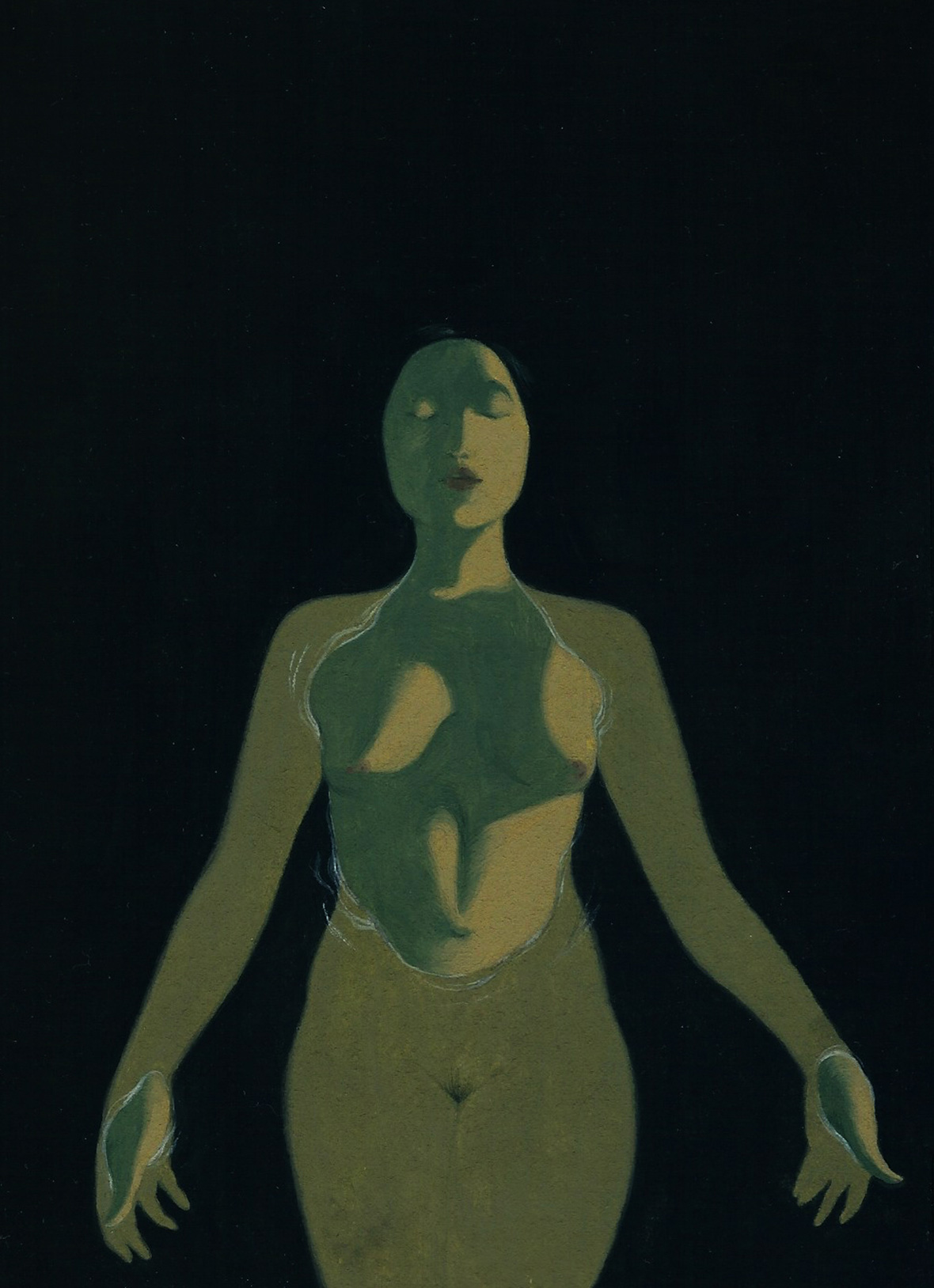
Like our stories? Follow us on Facebook and Instagram.
Website: www.taquynhmai.com
Contributor: Uyen Dinh
Chinese Translation: Olivia Li

